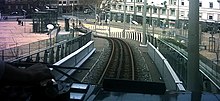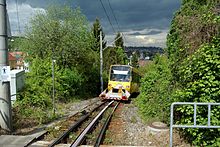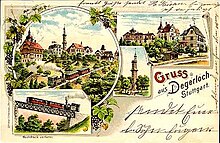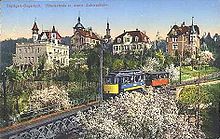Stuttgart rack railway
| Stuttgart rack railway | |||||||||||||||||||||||||||||||||||||||||||||||||||||||||||||||||||||||||||||||||||||||||||||||||
|---|---|---|---|---|---|---|---|---|---|---|---|---|---|---|---|---|---|---|---|---|---|---|---|---|---|---|---|---|---|---|---|---|---|---|---|---|---|---|---|---|---|---|---|---|---|---|---|---|---|---|---|---|---|---|---|---|---|---|---|---|---|---|---|---|---|---|---|---|---|---|---|---|---|---|---|---|---|---|---|---|---|---|---|---|---|---|---|---|---|---|---|---|---|---|---|---|---|
| Course book range : | none, ex 319 (1944) | ||||||||||||||||||||||||||||||||||||||||||||||||||||||||||||||||||||||||||||||||||||||||||||||||
| Route length: | 2.2 km | ||||||||||||||||||||||||||||||||||||||||||||||||||||||||||||||||||||||||||||||||||||||||||||||||
| Gauge : | 1000 mm ( meter gauge ) | ||||||||||||||||||||||||||||||||||||||||||||||||||||||||||||||||||||||||||||||||||||||||||||||||
| Power system : | 750 (originally 600) volts = | ||||||||||||||||||||||||||||||||||||||||||||||||||||||||||||||||||||||||||||||||||||||||||||||||
| Maximum slope : | 200 ‰ | ||||||||||||||||||||||||||||||||||||||||||||||||||||||||||||||||||||||||||||||||||||||||||||||||
|
|||||||||||||||||||||||||||||||||||||||||||||||||||||||||||||||||||||||||||||||||||||||||||||||||
The Stuttgart rack railway was opened on August 23, 1884 and connects the Heslach district in the south district, i.e. the city center in the valley, with the Degerloch district, which was incorporated in 1908 . It is meter gauge built according to the Riggenbach system and is operated by the Stuttgarter Straßenbahnen AG (SSB). In the vernacular, the railway is called Zacke or Zacketse , it is considered a Stuttgart landmark.
In addition to the Zugspitzbahn , Wendelsteinbahn and Drachenfelsbahn , it is one of only four cog railways left in Germany. It is the only one that is not primarily used for tourist purposes, but for regular local public transport (ÖPNV). The Stuttgart rack railway has therefore also been integrated into the SSB line numbering system since May 1959, initially as line 30 , and since the introduction of the Stuttgart Transport and Tariff Association (VVS) in October 1978 as line 10 . From a legal point of view, today it is a tram according to the tram construction and operating regulations (BOStrab).
A special feature of the Stuttgart route is a deep rack , as it originally ran primarily directly in the road surface, similar to a tram. This means that the rack is not higher than the top edge of the rails. Other rack and pinion railways usually have an overhead rack where possible. The main gear is arranged so high that its lower edge is slightly above the height of the normal running rails. The advantage of the high rack is that such rack-and-pinion rail vehicles can also drive on ordinary points without a rack. This means that they can be used without the complex installation of the rack. It is also possible to dispense with the toothed rack on relatively flat inclined front or intermediate sections. In addition, the vehicles could theoretically switch to adjacent routes that are used in friction mode, which is operationally advantageous, but not possible in Stuttgart.
Route description
The route begins today on Marienplatz in the southern district. Immediately after the descent, the cog railway crosses Filderstraße and leads uphill on its own route to the intersection of Alte Weinsteige and Liststraße. There the line meets the old route (1884 to 1936), which today is only an operating line to and from the depot . This is housed in the former valley station, the so-called Filder train station . From Liststraße, the cogwheel railway runs mostly along the Alte Weinsteige , the historic main street, up to the Filder plain .
On the first 1.7 kilometers from Marienplatz, an altitude difference of 207 meters (266 meters to 473 meters above sea level ) is conquered, on the last 500 meters it drops by three meters. The maximum gradient is 17.8 percent (between the Liststraße and Pfaffenweg stops ) and 20.0 percent on the operating route to the depot. Between Pfaffenweg, the Wielandshöhe, where the Michelin-starred restaurant by Vincent Klink is located, and the Haigst there is a panoramic view of the city center in the Stuttgart basin .
The route of the cog railway is single-track, only at the Wielandshöhe stop there is a siding that is used in left-hand traffic . The platforms of the stops Liststraße, Haigst, Nägelestraße and Degerloch are seen uphill on the left, those of the stops Marienplatz, Pfaffenweg and Zahnradbahnhof are on the right. The Wielandshöhe crossing station has a central platform. At the Nägelestraße stop there are two platforms that are separated according to the direction of travel and are separated from each other by a level crossing. The cog railway runs mainly on its own track with Vignole rails ; Grooved rails are only used in the area of the level crossings , some stops and the property entrances .
business
Regular operation
There is a fixed 15-minute cycle , for which two circuits are required. Only on Sundays and public holidays does the rack railway run from the start of operation until 8:00 a.m. every 30 minutes with just one car. The journey takes ten minutes in both directions, the turning time at Marienplatz is six minutes and at Degerloch four minutes. The railcars of the rack railway always run as single wagons. Multiple traction units are not possible because the platforms are limited to around 20 meters in length. In addition, there are no vehicles for a multiple traction.
Late traffic
A special feature is the from 21:00 conducted daily replacement bus service with trains running at 20-minute intervals route taxi . This cannot serve the Nägelestraße stop in either direction and does not stop at the cog railway station, but in both directions at the Karl-Pfaff-Straße night bus stop. In the direction of Marienplatz, the Lehenstraße stop of bus line 43 is also served. The reason for this taxi operation is, in addition to the lower number of passengers in the evening hours, the lack of noise pollution for the residents of the cog railway. The taxi can be used at the regular VVS tariff, prior notification is not required. With a journey time of only seven minutes, the taxi is three minutes faster than the train.
Bicycle transport
Another characteristic feature of the Stuttgart cog railway is the introduction of bicycles on a short, flat two-axle presentation wagon on May 1, 1983 after the second generation of vehicles was finally decommissioned . The passengers load their bikes themselves, with these standing across the direction of travel. The transport of bicycles is only permitted on the entire route from end station to end station and only uphill. This is the only way to ensure that there are no delays due to loading and unloading processes en route. In addition, from the driver's cab on the mountain side, the driver can check whether a bicycle might come loose from its anchoring while driving. The take away option is also very popular with downhill riders. On nice days, all ten parking spaces are often occupied in the afternoon. As is customary in the VVS, bicycle transport is free of charge. Because the transfer table in the depot is too short for a cogwheel rail car with an introductory car, the introductory cars are parked at the Degerloch terminus at night. When the snow cover is closed, they also remain out of operation because there is then a risk of derailment for the light wagons.
history

On August 23, 1884, the originally 1.93 km long, steam-powered rack railway from Stuttgart to Degerloch was opened as the first line of the Filderbahn-Gesellschaft (FBG). Legally, it was originally a railroad . After the Kirchheimer Eisenbahn-Gesellschaft (since 1864) and the Ermsthalbahn-Gesellschaft (since 1873), the narrow-gauge railway to Degerloch was the third private railway in Württemberg . The valley station of the cog railway, which at that time was still on the outskirts of the city, was initially only connected to the Stuttgart central station in Schloßstraße by means of the local horse-drawn tram . Back then, the cogwheel railway ran through largely undeveloped terrain.
Parallel to the Stuttgart facility, the rack railways to the Drachenfels , Rüdesheim-Niederwald , Asmannshausen-Niederwald , Salzburg-Gaisberg , Königswinter-Petersberg and Jenbach-Achensee all built according to the Riggenbach system. Vehicles and tracks came from the Esslingen machine factory . Niklaus Riggenbach mostly supervised the construction personally. The locomotives for the Achenseebahn were built by the Floridsdorf locomotive factory , but based on plans from Esslingen. The vehicles were all identical or differed only minimally. Thus, the Achenseebahn still gives an impression of what the trains of the Stuttgart rack railway originally looked like.
In 1886, the Filderbahn company set up the Hohenwaldau intermediate station at the Degerloch observation tower, today's Nägelestrasse stop . In 1888, the Degerloch train station also became the end point of the meter-gauge friction line to Möhringen and thus a transfer station. In Möhringen, this line was transferred to the railway line to Hohenheim . The Degerloch station received sidings and a wooden wagon hall. It was popularly called a dog house because of its characteristic design .
On July 11, 1902, the rack railway and the friction lines Degerloch – Hohenheim and Möhringen – Vaihingen were electrified . However, the start of scheduled electrical operation on the cogwheel line was delayed by two years due to technical problems. With the start of electric traction, steam operation was finally limited to excursion traffic on Sundays. In 1903 the turnout was relocated from Haigst to Wielandshöhe.
In 1920 the city of Stuttgart took over the Filderbahn-Gesellschaft, which from then on traded as the Städtische Filderbahn (SFB), and transferred the management of the company to the Stuttgarter Straßenbahnen AG. In the following year, steam operation was finally stopped. In 1926 all passenger vehicles on the cogwheel and the Filderbahn were repainted in the SSB color scheme. To distinguish them from SSB's own vehicles , however, the Filderbahn wagons were temporarily given an additional "F" in front of their vehicle number.
In 1932 the Pfaffenweg stop went into operation. In 1934 the lines of the former Filderbahn company, including the rack railway, finally became the property of the Stuttgarter Straßenbahnen AG. On December 21, 1936, the final stop on the valley side was relocated to Marienplatz (at that time the SA's place ), for this purpose a residential building on Filderstrasse had to be demolished. This resulted in a better connection with the tram.
In 1965 a new reinforced concrete bridge was built over the Neue Weinsteige to replace the old steel lattice bridge. It was popularly known as the Turk's Bridge , as it was originally intended for delivery to Turkey by the manufacturer, Maschinenfabrik Esslingen . In 1971, as part of the construction work for the Stuttgart urban railway, Marienplatz was redesigned and the underground tram stop was created. In this context, the SSB replaced the double-track valley station of the rack railway with a single-track station, which partially extended to the adjacent bridge. It was located above a later filled water basin. In 1977 the cog railway became an island route in the SSB network after the connection to the adhesion railway was discontinued as part of the redesign of the Degerloch cog railway. A year later, the scheduled operation with three-car trains was discontinued.
With the delivery of the Filderbahn low-side car 3034 (built in 1897) to the SSB in 1978, which used it as a ballast wagon on the tram network for two more years, the last only sparsely carried out in the form of material transports on the cog railway ended. In 1980 the entire cog railway line was renewed for the use of the new ZT 4 railcars . In this context, when the superstructure was renewed, the original Riggenbach type ladder rack was gradually replaced by a milled broad head profile. It corresponds to the Swiss “ von Roll ” design, but still falls under the Riggenbach system. SSB's track construction yard produces these rack profiles itself.
On December 16, 1994, a 200-meter-long route extension to Degerlocher Albplatz was carried out on the mountain side to improve the connection with the Stuttgart city railway . On December 6, 2002, the newly built valley-side terminus at Marienplatz, including the connecting bridge, was opened on the completely redesigned Marienplatz. 2004 was railway - superstructure renewed and relocated parts of the rack again.
vehicles
Steam locomotives
Between 1883 and 1885, Maschinenfabrik Esslingen (ME) delivered the first three cogwheel steam locomotives with the names Stuttgart (model locomotive, already used to build the line and in use until 1921), Degerloch (sold in 1914 for scrapping) and Filder (sold in 1902 for scrapping ).
The first generation of locomotives was completed in 1898 by the acquisition of the Alb and Aussicht steam locomotives of the Petropolis type from the Esslingen machine factory, both of which were scrapped in 1922. They were built for Brazil in 1892 by a subsidiary of the machine factory in Saronno , but were not accepted there.
Due to the increased steam operation due to the war , two additional steam locomotives were taken over from the Swiss Brünigbahn in 1918 . These were scrapped in 1922.
Presentation trolley for people
With some rack railways, sidecars may only be carried on the mountain side for safety reasons. In this way, an uncontrolled descent can be avoided if the clutch breaks.
In 1884 the first four presentation cars 15 to 18 (types 1 and 2) were delivered. In the years 1893 and 1900, respectively, four open summer cars followed with the road numbers F1 to F4 (type 3; from 1922 parked and dismantled, wheelsets kept as a reserve). Between 1896 and 1900 the A3 to A8 (Type 4) cars were delivered, four of which were in daily use under the SSB road numbers 117–120 until the ZT 4 railcars were introduced in the 1980s. In return, the types 1 and 2 wagons were used on the Filderbahn adhesion lines. In 1906 they were finally sold to the Härtsfeldbahn , which at that time belonged to the Badische Lokal-Eisenbahnen (BLEAG) . There they were scrapped between 1908 and 1958.
In 1927, the introductory car 116 was rebuilt on an old chassis from 1896. In 1937, the SSB 120 sidecars converted into a prototype with a closed brake platform on the mountain side; the rest of the cars were converted in 1952.
In 1956, the Filderbahn sidecar number 153 was handed over to the cog railway to reinforce school traffic. Because of its unconventional interior design, uncomfortable on steep slopes, with transverse and longitudinal bench seats and missing interior doors, as well as the lack of a brake gear, the vehicle was not particularly popular with passengers or drivers. As a result, it was extremely rare and only in use until 1965.
In 1961, single-arm pantographs , which had previously been mounted on a GT4 as a trial, were used to preheat the wagons and to de-ice the catenary on wagons 119 and 120.
As a result of the cessation of the scheduled three-car train operation, the superfluous Vorstellwagen 119 was given in 1978 to the former German Tram Museum ( DSM), now the Hanover Tram Museum (HSM) in Sehnde-Wehmingen. Since March 2009 it has been with the Härtsfeld Museum Railway (HMB) in Neresheim and is to be restored as a passenger car for use on the narrow-gauge line.
Private collectors took over Vorstellwagen 116 in 1982 (after stopovers in Aalen and Schönau , where the car was to be used in various projects of a former Stuttgart Tram Museum Association. However, it was mostly unprotected in the open air and was handed over to the Härtsfeld Museum Railway in 1997 for refurbishment ) and presentation car 120 (returned to Stuttgart in 1984 after the failure of the museum railway project in Aalen).
With Vorstellwagen 117 from the year of construction 1896, the oldest and longest used passenger vehicle of the SSB was taken out of operation in 1983 and sold to a private collector, who erected it as a memorial in Leinfelden-Echterdingen . In 1992 it was sold to the Härtsfeld Museum Railway, which today uses it as a passenger car on its museum route.
With the handover of sidecar 119 in 2009, all remaining cogwheel train presentation wagons of type 4 are now in the care of the Härtsfeld Museum Railway in Neresheim, in addition to the 118 and 120 wagons that have been preserved in a museum in Stuttgart. While sidecar 117 has been in use again there under the number HMB 1 since 2001, the wagons 116 and 119 require a thorough overhaul beforehand because they have been parked outdoors for years.
Electric railcars
First generation
In 1902 the first four electric railcars were delivered . They came from the Herbrand & Cie. , however, proved to be too weak with their single, valley-side engine. The electrical planned operation could only be started in 1904 after the installation of a second motor on the mountain side. A fifth railcar of this type finally followed in 1912. Railcar 109 is the last of this series to be decommissioned in 1954.
Second generation
In 1935 the first new, three-axle railcars with the road numbers 101 (in use until 1982) and 102 (scrapped in 1974 due to some damage) were delivered. With railcar 103, the first SSB vehicle in all-steel construction was delivered in 1937; it is still available today at a private collector. In 1950, the last two second-generation railcars were delivered, 104 (now a museum car) and 105 (dismantled in 1995). The car body of the recently decommissioned railcar 102 was carried along as an attraction in the Stuttgart carnival parade in 1974.
Railcar 103 was also taken over by private collectors in 1982 and is still available today in the Swabian Farmers and Technology Museum in Seifertshofen .
The museum train, which was originally operational in the depot on Filderstraße and made up of railcar 104 and introductory car 120, whose railcar suffered engine damage during the anniversary runs in 1984, has since been parked and found in 1995 together with the introductory car 118, which has also been preserved in a museum, in the newly opened Tram Museum in Zuffenhausen (today Tramworld Stuttgart ) a new place to stay. Political initiatives for an operational remanufacturing of the train have since remained unsuccessful.
In 1983, the SMS Museum Association acquired the car body of railcar 101 ( scrapped in Schönau in 1997 ) and railcar 105 (dismantled there in 1995; a drive unit is now on loan from the Stuttgart Historic Tramway Association ), with the latter remaining as an operating reserve at the until the end of 1983 Rack railway remained.
On April 29, 1983, together with car 118, it formed the last scheduled cogwheel train made up of an old railcar and a presentation car. In 1984, as part of the 100th anniversary celebration, a traditional cogwheel train was used for the last time, made up of the motor car 104, which had been in operation up until then, and the presentation car 120.
Third generation
In 1982, the SSB introduced the third generation of electric rack-and-pinion railcars with the ZT 4 multiple units in the design of the DT 8 light rail multiple units. In 1989 the previous swinging sliding doors were replaced by the DT 8 corresponding outward swinging doors. In 1995, on the occasion of the 111th anniversary of the cog railway, railcar 1003 was named Helene , after the Degerloch benefactress Helene Pfleiderer , daughter of the contractor Gustav Epple.
Fourth generation
In 2018, SSB ordered three rack-and-pinion railcars and three four-axle bicycle display cars from the Swiss manufacturer Stadler for 19.3 million euros, which are to be used from 2021. Like the ZT 4, they will have 54 seats. Unlike these, they will have a low-floor area with a floor height of 40 cm. In order to enable barrier-free entry, the platforms of the stops are to be rebuilt. The bicycle trolleys will be able to carry 21 instead of the previous ten bicycles and should be quieter than the previous cars.
Presentation trolleys for bicycles
There are a total of three bicycle presentation cars with the company numbers 1980 (year of construction 1983), 1981 (year of construction 1983) and 1982 (year of construction 1986). The first two were manufactured by Waggon Union , while the third was self-built by SSB.
literature
- Ulrich Theurer: 100 years of the Stuttgart – Degerloch cog railway .
- Dirk von Harlem: New rack-and-pinion railcars for Stuttgart . Technical description.
- Tram magazine . Issue 53. Franckh'sche, August 1984, ISSN 0340-7071 , p. 163 ff .
- Gottfried Bauer: Tram in Stuttgart. "Over mountain and valley" with the SSB . GeraMond, Munich 2003, ISBN 3-7654-7188-7 .
- Gottfried Bauer, Ulrich Theurer, Claude Jeanmaire: A documentation about the cogwheel and Filderbahn, Cannstatter Strassenbahnen GmbH, Stuttgart suburban trams, Esslingen municipal trams, Esslingen-Nellingen-Denkendorf trams, Feuerbach urban trams, Feuerbach-Ludwigsburg GmbH trams . In: Trassenbahnen um Stuttgart / Tramways around Stuttgart (Germany) . Eisenbahn, Villigen (AG) 1984, ISBN 3-85649-047-7 .
- The new rack railway bridge over the Obere Weinsteige . In: Over mountain and valley . Issue 4 (year 26), August 1965.
- Hans-Joachim Knupfer: The train to a beautiful view . Stuttgart's rack railway. Stuttgart trams, Stuttgart 2009, ISBN 978-3-9811082-2-4 .
Web links
- Information from Stuttgarter Straßenbahnen AG about the rack railway
- Details of all locomotives
- Interactive 360 ° panorama image in the driver's cab of a railcar (Flash / HTML5)
- Wolfram Berner: Rack Railway , published on April 19, 2018 in: Stuttgart City Archives: Stuttgart City Lexicon .
Individual evidence
- ^ Course book 1944
- ↑ Heike Armbruster: A homage to the Zacketse , article in the Stuttgarter Zeitung of June 12, 2012, online at stuttgarter-zeitung.de, accessed on January 21, 2019
- ↑ The Nägelestraße stop on www.filderbahn.net ( Memento from August 22, 2010 in the Internet Archive )
- ↑ The Pfaffenweg stop on www.filderbahn.net ( Memento from August 22, 2010 in the Internet Archive )
- ↑ Much new to the Zacke. Stuttgarter Straßenbahnen AG, December 17, 2018, accessed on January 21, 2019 .
- ↑ traminfo.de
Coordinates: 48 ° 45 ′ 18.8 ″ N , 9 ° 10 ′ 20.4 ″ E























